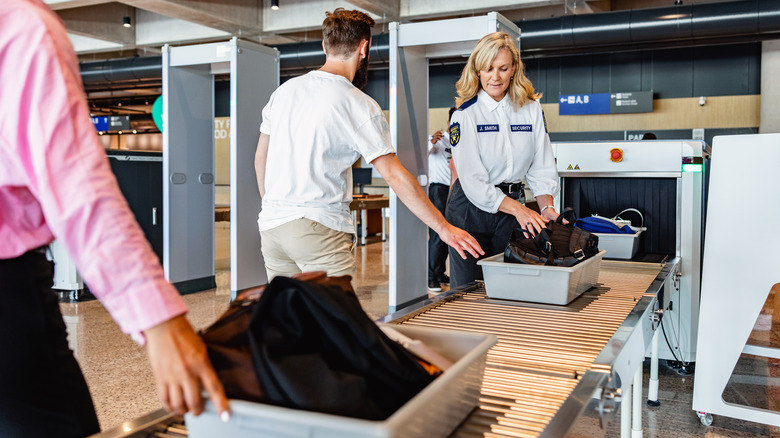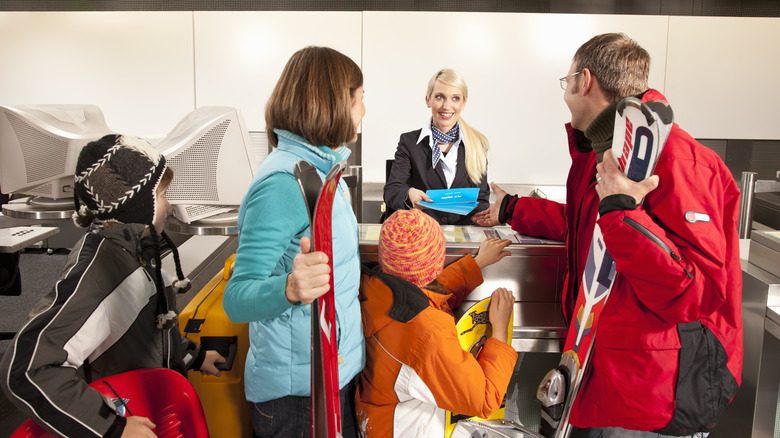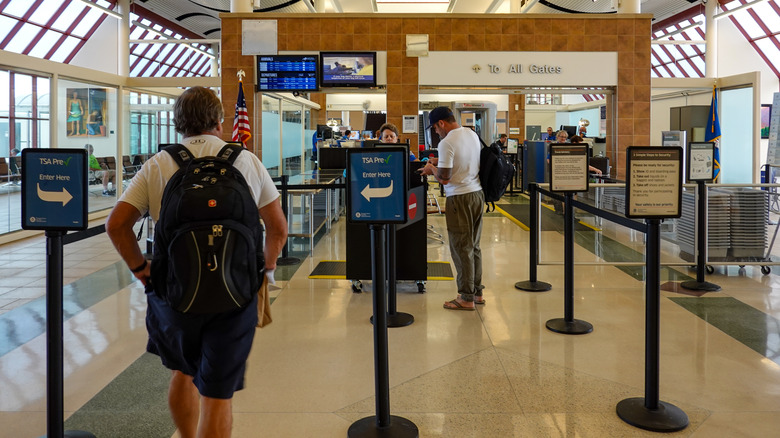The Sports Gear TSA Won't Let You Carry On A Plane
TSA's inconsistency and complicated regulations of what is and isn't allowed can give even seasoned travelers a headache. When it comes to sports equipment, most general sports equipment not used to whack a ball or puck is also allowed through TSA checkpoints. This includes helmets, basketballs, bowling balls, soccer balls, trophies, and skates as well as tennis rackets and pickleball paddles. However, per TSA regulations, some items that are allowed through may require additional screening, and the final decision to allow an item is up to the individual screening officer. Even if your items can make it through the checkpoint, be sure to know your airline's rules for the weight and size of carry-on items so you don't delay your flight with bulky luggage.
Even though the sizes and quantities of liquids and gels may not be as strictly enforced as in the past, TSA strictly prohibits items in carry-on luggage that can be used as a bludgeon or considered a weapon. This list includes hockey sticks, bowling pins, baseball bats, ski poles, walking sticks, and golf clubs. Other equipment, such as tennis rackets, pickleball paddles, and skateboards, are allowed through the checkpoint, provided they will fit in the overhead bin and meet your airline's regulations.
Although general sports equipment is not prohibited, be sure to carefully check your luggage for any prohibited items before going through security. Travelers who are caught bringing items deemed as weapons or explosives through the checkpoints can be fined and may receive a criminal referral, depending on the severity of the infraction.
Flying with oversized sports equipment
Travelers bringing larger sports equipment will have to not only comply with TSA regulations but also with their airline of choice. By law, TSA must inspect every piece of luggage that travels on commercial aircraft from or within the United States. Even though most of the 1.4 million bags a day screened by TSA do not need a visual inspection, many passengers traveling with bicycles, skis, or other oversized equipment often receive a notice that their bags have been opened and checked by TSA to confirm there are not prohibited items inside.
If you are planning to fly and are bringing your sports equipment, be sure to pack your items well, as the officers may have a look inside and not repack diligently. As each airline has different guidelines and policies for sports equipment, scour your airline's web page for details including size, weight limits, and additional fees. Most major airlines do not charge extra for skis, snowboards, and golf bags, as long as they meet the airline's standard requirements for checked luggage.
Before you check in your bike bag, ski bag, or golf bag, make sure to put all hand tools and wrenches in your checked bag to ensure they make it through. Although TSA officially allows tools under 7 inches in carry-on bags, it is ultimately up to the screening officer whether your Allen wrenches, pliers, or multi-tools are allowed through security. Although packing everything together in one bag is more convenient, if you are just over your airline's checked luggage weight limit, bicycle chains and pumps are allowed in your carry-on, as is ski wax, as long as it's not flammable and is under 3.4 ounces. Finally, don't forget to lock your bag with a TSA-approved lock. However, if you don't have one, try this no-lock luggage trick to keep your zippers more secure.
Speeding through TSA with sports gear
Many TSA checkpoints are the bane of efficiency, and at peak times they can be incredibly crowded. Getting flagged by TSA for not following the rules will slow down the screening process for you and other travelers who are moving through the line. If you are looking to speed through security, consider signing up for TSA PreCheck. You'll be able to leave all of your items in your carry-on luggage and can keep your shoes and clothing on as you breeze through security. PreCheck costs $78 for five years of benefits, and the approval process often takes less than a week. Depending on when and where you fly, it may even save you from missing a flight due to being stuck in the security line at major U.S. airports.
Save your time and tools by double-checking your carry-on and personal item for anything that would trigger the alarm at the security checkpoint before you check in your sports equipment. Once you've checked in a bag, you will not be able to access it until you arrive at your destination. While going through security, if a TSA agent determines an item is unsafe to fly, you will either have to put the item in your car, return to check-in and check a second bag, or have TSA dispose of the item for you. Mailing the item may be an option as well, but it will depend on the airport.
As TSA agents are there to protect the traveling public, remember to follow all of their procedures and remain focused on getting through the checkpoint. Being aware of TSA's red flags may save you time so you can de-stress and get to the gate (or your overpriced coffee) faster.


